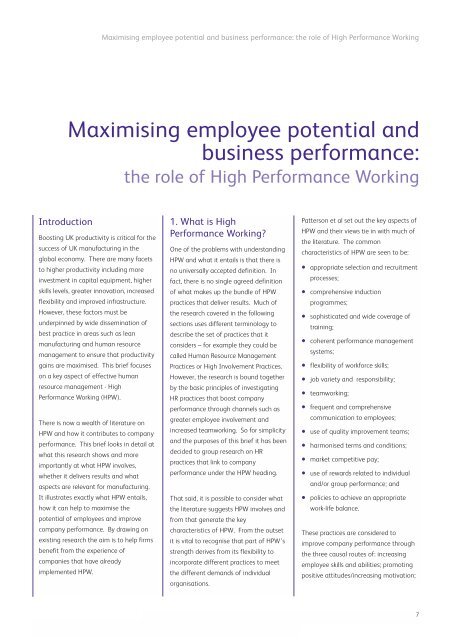About EEF - CIPD
About EEF - CIPD
About EEF - CIPD
Create successful ePaper yourself
Turn your PDF publications into a flip-book with our unique Google optimized e-Paper software.
Maximising employee potential and business performance: the role of High Performance WorkingMaximising employee potential andbusiness performance:the role of High Performance WorkingIntroductionBoosting UK productivity is critical for thesuccess of UK manufacturing in theglobal economy. There are many facetsto higher productivity including moreinvestment in capital equipment, higherskills levels, greater innovation, increasedflexibility and improved infrastructure.However, these factors must beunderpinned by wide dissemination ofbest practice in areas such as leanmanufacturing and human resourcemanagement to ensure that productivitygains are maximised. This brief focuseson a key aspect of effective humanresource management - HighPerformance Working (HPW).There is now a wealth of literature onHPW and how it contributes to companyperformance. This brief looks in detail atwhat this research shows and moreimportantly at what HPW involves,whether it delivers results and whataspects are relevant for manufacturing.It illustrates exactly what HPW entails,how it can help to maximise thepotential of employees and improvecompany performance. By drawing onexisting research the aim is to help firmsbenefit from the experience ofcompanies that have alreadyimplemented HPW.1. What is HighPerformance Working?One of the problems with understandingHPW and what it entails is that there isno universally accepted definition. Infact, there is no single agreed definitionof what makes up the bundle of HPWpractices that deliver results. Much ofthe research covered in the followingsections uses different terminology todescribe the set of practices that itconsiders – for example they could becalled Human Resource ManagementPractices or High Involvement Practices.However, the research is bound togetherby the basic principles of investigatingHR practices that boost companyperformance through channels such asgreater employee involvement andincreased teamworking. So for simplicityand the purposes of this brief it has beendecided to group research on HRpractices that link to companyperformance under the HPW heading.That said, it is possible to consider whatthe literature suggests HPW involves andfrom that generate the keycharacteristics of HPW. From the outsetit is vital to recognise that part of HPW’sstrength derives from its flexibility toincorporate different practices to meetthe different demands of individualorganisations.Patterson et al set out the key aspects ofHPW and their views tie in with much ofthe literature. The commoncharacteristics of HPW are seen to be:• appropriate selection and recruitmentprocesses;• comprehensive inductionprogrammes;• sophisticated and wide coverage oftraining;• coherent performance managementsystems;• flexibility of workforce skills;• job variety and responsibility;• teamworking;• frequent and comprehensivecommunication to employees;• use of quality improvement teams;• harmonised terms and conditions;• market competitive pay;• use of rewards related to individualand/or group performance; and• policies to achieve an appropriatework-life balance.These practices are considered toimprove company performance throughthe three causal routes of: increasingemployee skills and abilities; promotingpositive attitudes/increasing motivation;7
















